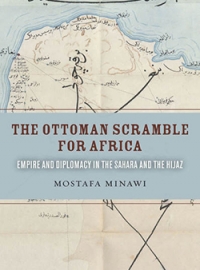|
Reviewed by Wyndham Whynot, Ph.D., Professor of History, Livingstone College Major European participants of the 1884-1885 Berlin Conference signed a treaty establishing “ownership” of colonies currently held by European powers and rules for acquiring title to additional unclaimed African territory. While many might first think of Great Britain and France or even lesser European powers, few would likely mention the Ottoman Empire’s role in Africa. Whereas most works on the “Scramble for Africa” rarely mention the Ottomans, Minawi’s work explains that despite the lack of long-term success, the Ottomans actively engaged in diplomatic activity in northern Africa and southwest Asia in their effort to maintain their imperial interests in both regions. Chronologically focusing on the reign of Sultan Abdul Hamid II and the events of his era, Minawi also geographically restricts his focus on the “eastern Sahara, Lake Chad basin, and western Arabia” (p. 4). He notes the empire faced significant challenges in its Balkan provinces and that other Great Powers in Europe were threatening Ottoman interests in their African and Arabian provinces; especially the frontiers. Although referred to as the “Sick Man of Europe,” the author argues that the Ottoman Empire was quite active in European imperialism of the late 19th and early 20th century. Framing his narrative partially around the career of Sadik al-Mouayad Azmzade, an Ottoman officer, Minawi examines Ottoman diplomacy in the post-Berlin conference era, Africa. Quickly discussing the physical and cultural geography, as well as the history of the African regions the empire was interested, the author examines efforts by the Ottomans to reach an understanding or alliance with the Sanusi Order and a brief history of the group. The Sanusi’s provided two avenues for increasing Ottoman claims to their North African territories. Their influence with various Berber groups provided the Ottomans with a potential partner or ally to fend off European and a Madhist attempt to seize control over the empire’s sphere of influence. Additionally, Sanusi zāwiyas, a civil-social type compound, could serve as evidence of a permanent presence in the region. Minawi then shifts his focus to the empire’s diplomatic efforts amongst the European powers and the failure of those powers to deal fairly with the Ottomans. Despite Ottoman willingness to abide by the Berlin Conference agreement, European powers were not willing to accord the same respect toward Ottoman interests. As a result, the empire attempted a more aggressive approach, to maintaining their North African sphere of influence. The author notes the Ottoman Empire offered military assistance so that the Sanusi’ Order to resist European encroachment of the Sanusi lands. Additionally, European failure to treat Ottoman concerns appropriately, the empire began isolating itself from inter-imperial cooperative efforts in constructing major infrastructure projects to In his final part, the author examines the Ottoman policies surrounding the proposed construction of a telegraph from Damascus to Mecca. Compared to difficulties faced in building a line in Ottoman Libya, erecting a telegraph in the Hijaz should have been much easier, yet Minawi argues various problems confronted the Sultan in his attempts to extend wire communications in the Hijaz. Conflicts within different departments and regions resulted in various delays and failure to complete, as well as whether the telegraph route should be overland or underwater. Minawi argues that this second line exposed significant difficulties existing between the authorities in Istanbul and those governing in the provinces. Although occasionally shifting the narrative to the first person, the book is well written. Minawi conducted extensive research, heavily relying upon official Ottoman Archives in Turkey, as well as the British National Archives and the United States Library of Congress. Additionally, several newspaper archives in Turkey and Lebanon are also used. Furthermore, the author uses numerous published and secondary sources in his research. During his discussions throughout the chapters, Minawi provides a variety of photographs and maps relating to the topics he is examining. Despite the maps’ overall usefulness, several of them are in Ottoman script with no translations provided, thus limiting the reader’s ability to use the maps fully. Minawi’s work offers a fresh perspective into the Ottoman Empire’s African diplomacy during the Scramble for Africa, one that other scholars examining Europe’s race to claim Africa often overlook. In some ways, his main book title, “The Ottoman Scramble for Africa,” fails to address the focus of his book adequately, however, in this reviewer’s opinion, his subtitle would have been a more appropriate title. Still, scholars and readers interested in learning about Ottoman engagement in North Africa would find this book very useful. |


 The Ottoman Scramble for Africa: Empire and Diplomacy in the Sahara and the Hijaz
The Ottoman Scramble for Africa: Empire and Diplomacy in the Sahara and the Hijaz
